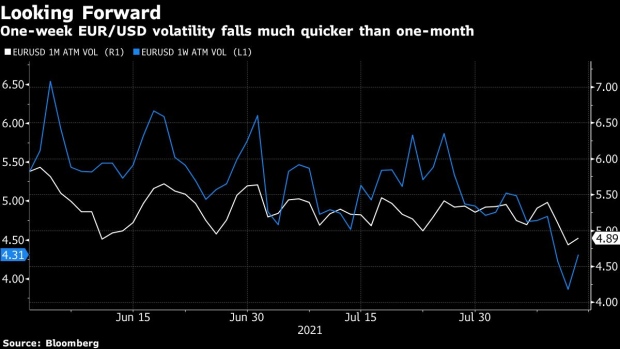Aug 13, 2021
Jackson Hole Is Shaping Up to Be a Dud for U.S. Dollar Traders
, Bloomberg News

(Bloomberg) -- The Federal Reserve’s eagerly awaited Jackson Hole symposium later this month may end up being a dud, at least in terms of its potential to sway currency markets.
Euro/dollar implied volatility around the Aug. 26-28 event suggest smooth sailing, according to TD Securities’ Mazen Issa. Instead, investors may be waiting for the Sept. 3 U.S. payrolls report and Sept. 22 Fed rate decision to guide their currency positions, the strategist said.
“We think the symposium may not have a whole lot to offer on USD direction,” Issa said.
One-week implied volatility in the euro/dollar pair is down nearly a full percentage point this week to 3.78%, the lowest since February 2020, while one- and three-month volatility fell less than half a point. The difference suggests investors may be looking past Jackson Hole, Issa said.
The drop comes amid a broader fall in currency implied volatility as global share prices hit record highs, upending those who anticipated seasonal weakness. For euro/dollar specifically, real money demand helped drive spot away from its year-to-date low and realized one-week volatilities dropped to 3.31%, the lowest level since December 2019.
“Until the Fed solidifies its taper timeline, the USD is likely to remain rangebound,” Issa wrote. “The announcement of taper is not necessarily the trigger point, but rather the duration of that process and sequencing of policy (i.e. lift-off) that might be more influential for USD and rates direction.”
©2021 Bloomberg L.P.